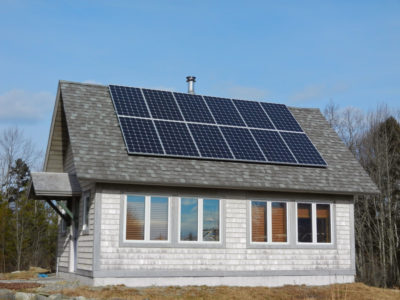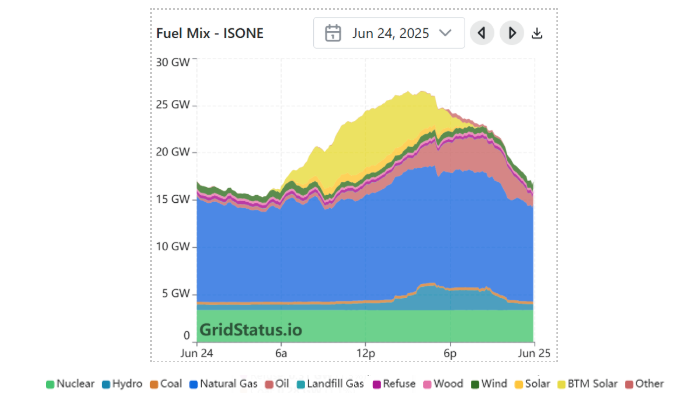June 24, 2025, was the hottest day in a record-breaking heat wave that swept New England and pushed demand on our regional power grid to near-record highs.
It’s exactly during heat waves like this, when demand for electricity surges due to air conditioning, that the capacity of our electricity system is strained to its maximum. In the case of June 24, the situation was exacerbated when a natural gas plant unexpectedly failed in the middle of the day, causing the regional grid operator to issue escalating emergency alerts.
Thanks in no small part to solar installed on rooftops across the region, which helped reduce demand on the grid by as much as 22%, we stayed within bounds and avoided rolling blackouts.

Wyman Station, by Beth Comeau
Overreliance on Fossil Fuels Creates Costly Vulnerabilities
The New England grid—and the electricity we consume in Maine—is still highly dependent on fossil fuels, with natural gas powering roughly 60% of generation year-round. It’s not unusual for natural gas plants to cause reliability emergencies like this, especially given our over-dependence on this single generator type.
Times of high stress on the grid due to gas plant failures or heat waves are when the dirtiest and most expensive fossil fuel plants are brought on-line to meet demand.
These “peaker” plants are typically antiquated coal- and oil-fired generators that are so expensive and polluting that they can’t justify operating under normal circumstances. Kept alive for times like these, peaker plants scattered across the region include Yarmouth’s Wyman Station, overlooking Casco Bay, which first began operations almost 75 years ago in 1957.
During the June 24 heat wave, these oil-fired clunkers met a whopping 12% of electricity demand, pushing up wholesale electricity prices in excess of $1,110/MWh, 17 times what they were one week earlier, and 25 times average prices.
And electricity prices would have been even higher were it not for solar.
Rooftop Solar Depresses Market Prices, Provides Power Where and When It’s Needed
While solar makes up only a tiny fraction of power on the New England wholesale market, what’s operating on rooftops throughout the region is having a big impact in aggregate.
These 7.8 GW of solar panels are installed “behind-the-meter” on homes and businesses, reducing demand at its source, which in turn reduces demand on the grid and lowers regional electricity market prices for everyone.
Solar resources are especially useful because the electricity they produce coincides with these expensive, high-stress times—during the hot afternoons in a heat wave. This has the effect of depressing market prices across the board by letting grid operators avoid having to bring on-line additional, expensive fossil-fuel generators. Here’s how it works:
With Zero Fuel Costs, Renewables Reduce the Prices Paid to All Generators
The way electricity markets are structured in New England, grid operators choose the least expensive resources first to meet projected demand for electricity. They then choose incrementally more expensive resources until demand is fully met for a given time period. In the real-time market this happens on five-minute intervals. The last resource to be brought on-line to meet demand is necessarily the most expensive and, when it is chosen, it sets a uniform clearing price paid to all generators used to meet demand in that time increment.
One counterfactual estimate of how much consumers saved on June 24 due to behind-the-meter solar runs as high as $19.4 million. That’s just for one day out of the year and looking only at savings on the real-time market.
 Solar Helps Relieve Strained Electrical Equipment During Heat Waves
Solar Helps Relieve Strained Electrical Equipment During Heat Waves
Because these distributed solar resources provide power closer to where it’s consumed, they reduce the amount of power flowing down from the regional system, avoiding strain on all the upstream electrical equipment.
This is particularly important during heat waves because transmission and distribution equipment like conductors, transformers, switches, breakers, etc., all have thermal limits—critical physical properties that reduce their capacity to carry electricity in high ambient temperatures.
Solar in Maine is Playing a Big Part
In Maine, we have 135 MW of solar installed on rooftops of homes and small businesses.
The 2019 expansion of our Net Energy Billing (NEB) program sparked an additional 506 MW of small-scale community solar projects that also provide this valuable load-reducing effect during heat waves. (Maine has another 527 MW of solar built through the NEB tariff program that participates in the wholesale market, producing power during hot summer days but without as many local benefits.)
Indeed, although the NEB program has been criticized for its alleged high costs (which pale in comparison to the high cost of fossil fuels and storm recovery) and the Legislature imposed a slate of retroactive penalties on solar customers and companies last month, it’s owing to Maine’s rooftop and community solar programs that we are in as strong a position as we are today.
In fact, Maine now ranks in the top five states for solar per capita due to policies and programs supported by advocacy from the Natural Resources Council of Maine (NRCM) and our partners.
Knowing what we know now—that we are standing on the edge of a renewable energy investment cliff with cuts to federal incentives that will raise electricity prices across the country—Maine’s NEB program never looked so smart.
Now we need to do what we can to shift our policy focus to energy storage.
Maine Needs Battery Storage Now to Extend the Benefits of Solar
Because behind-the-meter solar produces the most power when the sun is high in the sky, it reduces load when electricity demand is highest during the day. In Maine and across New England, “peak demand”—the highest amount of electricity consumed over the course of a year—has not only come down steadily since 2006 due to solar, but it’s also moved later in the day after solar has done its work.
As an example, on June 24, because behind-the-meter solar reduced demand during the hottest time of the day, the regional power system didn’t actually experience its peak until 6:00 p.m., staying high until around 9:00 p.m. (See Figure 1)

(Figure 1. Generation fuel mix in New England over June 24, 2025. As temperatures soared to record levels on Tuesday afternoon, people across New England were running their air-conditioners. Behind-the-meter solar (bright yellow) reduced demand from the regional grid as much as 22%. The full load shape shows what market demand would have been without these distributed solar resources. Wholesale prices peaked at 6 pm at $1,110/MWh, but would have been higher for longer were it not for solar. Source: https://www.gridstatus.io/charts/fuel-mix?iso=isone&date=2025-06-24)
Batteries installed both behind-the-meter and directly connected to grid (i.e., front-of-the-meter) can be managed such that they charge when solar is generating and discharge when solar drops off but demand remains high.
By incentivizing battery energy storage, we can prolong the benefits of our local distributed solar through this new evening peak period from 5:00-9:00 p.m., further reducing wholesale electricity prices and our dependence on fossil fuels.

Photo courtesy of ReVision Energy
Let Maine People Know the Actual Costs of Power
To do this effectively, we’ll need to support our investments in battery energy storage with consumer-facing prices that reflect actual costs. We can do this through well-designed Time-of-Use rates that give Maine homes and business options to save money by using less expensive power.
A bill sponsored by Rep. Gerry Runte that passed in June, which NRCM supported, brings us a step closer on this front. It will empower the Maine Public Utilities Commission to design rates that align supply and delivery costs in our electricity bills to create a price signal that’s strong enough to offer meaningful savings to Maine households for using electricity during off-peak times.
Hotter Temperatures Will Make Solar More Indispensable
In New England, peak electricity demand on June 24 was the highest seen in the region since 2013. Demand for cooling is pushing our power systems to their limits, not just in New England.
The North American Electric Reliability Institute (NERC) recently issued a warning about grid reliability during heat waves, emphasizing the importance of solar and batteries to help reduce strain on electricity systems across the continent.
2024 was the hottest year on record, and the last 10 years have been the 10 hottest years on record. 2025 isn’t far behind.
Distributed solar provides power where and when it’s needed, saving the region millions on hot days. While federal support for solar energy investments is going away, the problem it can help solve for is not.
—Rebecca Schultz, NRCM Senior Advocate, Climate & Clean Energy











Leave a Reply